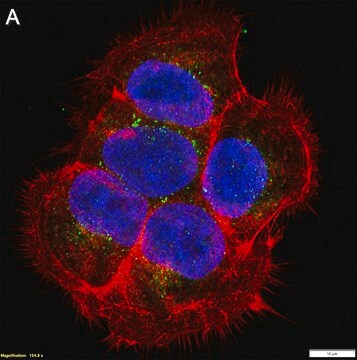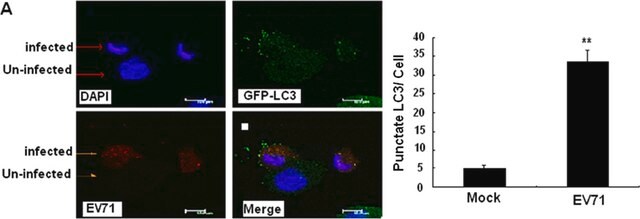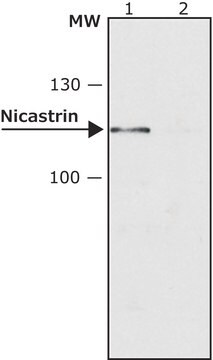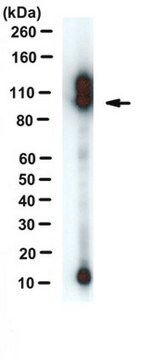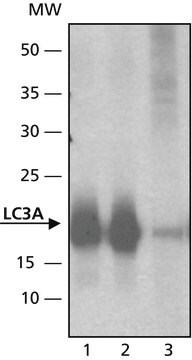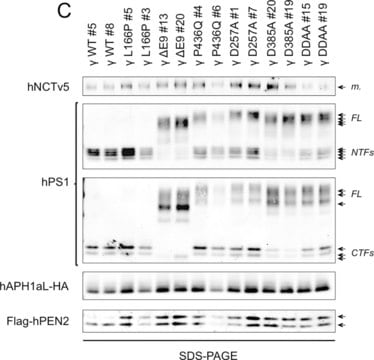詳細
We are committed to bringing you greener alternative products, which adhere to one or more of The 12 Principles of Green Chemistry.This antibody is Preservative-free, produced without the harm or sacrifice of animals and exceptionally stable to allow for ambient shipping and storage if needed and thus aligns with "Waste Prevention", "Designing Safer Chemicals" and "Design for Energy Efficiency".
Click here for more information.
ZooMAb® antibodies represent an entirely new generation of recombinant monoclonal antibodies.Each ZooMAb® antibody is manufactured using our proprietary recombinant expression system, purified to homogeneity, and precisely dispensed to produce robust and highly reproducible lot-to-lot consistency. Only top-performing clones are released for use by researchers. Each antibody is validated for high specificity and affinity across multiple applications, including its most commonly used application. ZooMAb® antibodies are reliably available and ready to ship when you need them.
特異性
Clone 2O13 is a Rabbit recombinant monoclonal antibody that specifically detects Presenilin-1. It targets an epitope within the C-terminal half.
免疫原
His-tagged recombinant fragment corresponding to 116 amino acids from the C-terminal half of human Presenilin-1.
アプリケーション
Quality Control Testing
Evaluated by Western Blotting in Jurkat cell lysate.
Western Blotting Analysis: A 1:1,000 dilution of this antibody detected Presenilin-1 in Jurkat cell lysate.
Tested applications
Western Blotting Analysis: A 1:1,000 dilution from a representative lot detected Presenilin-1 in lysates from NIH3T3 and SH-SY5Y cells and Rat brain tissue..
Immunohistochemistry (Paraffin) Analysis: A 1:100 dilution from a representative lot detected Presenilin-1 in human cerebral cortex tissue sections.
Affinity Binding Assay: A representative lot of this antibody bound Presenilin-1 with a KD of 1.8 x 10-9 in an affinity binding assay.
Immunocytochemistry Analysis: A 1:1,000 dilution from a representative lot detected Presenilin-1 in MCF-7 cells.
Note: Actual optimal working dilutions must be determined by end user as specimens, and experimental conditions may vary with the end user
ターゲットの説明
Presenilin-1 (UniProt: P49768; also known as PS-1, Protein S182) is encoded by the PSEN1 (also known as AD3, PS1, PSNL1) gene (Gene ID: 5663) in human. PS-1 and PS-2 are polytopic transmembrane proteins that share extensive amino acid sequence identity. They are functional components of separate high molecular weight complexes in the endoplasmic reticulum (ER) and Golgi apparatus and are essential for the proteolytic cleavage of several proteins, including βAPP and Notch. PS-1 is a multi-pass membrane protein with five cytoplasmic domain, nine transmembrane domains and five luminal domains. PS-1 is expressed in a wide range of tissues including various regions of the brain, liver, spleen, and lymph nodes. PS-1 can translocates with bound NOTCH1 from the endoplasmic reticulum and/or Golgi to the cell surface. Following its synthesis, PS-1 can be cleaved into 3 chains: Presenilin-1 NTF subunit (aa 1-298), Presenilin-1 CTF subunit (aa 299-467), and Presenilin-1 CTF12 (aa 346-467). The NTF and CTF fragments result from heterogeneous proteolytic processing. During apoptosis, the CTF can be further cleaved by caspase-3 to produce PS1-CTF12. PS-1 is the catalytic subunit of the g-secretase complex that catalyzes the intramembrane cleavage of integral membrane proteins such as Notch receptors and amyloid-beta precursor protein (APP). Its protease activity requires the presence of other members of the g-secretase complex. PS-1 is reported to play a role in Notch and Wnt signaling cascades and regulation of downstream processes. Over 40 different mutations have been reported in PS1 gene, which account for about 30 to 50% of all presenile familial Alzheimer s Disease (FAD). This ZooMAb® recombinant monoclonal antibody, generated by our propriety technology, offers significantly enhanced specificity, affinity, reproducibility, and stability over conventional monoclonals. (Ref.: Zhang, S., et al. (2013). Transl. Neurodegener. 2(1); 15).
物理的形状
Purified recombinant rabbit monoclonal antibody IgG, lyophilized in PBS, 5% Trehalose, normal appearance a coarse or translucent resin. The PBS/trehalose components in the ZooMAb formulation can have the appearance of a semi-solid (bead like gel) after lyophilization. This is a normal phenomenon. Please follow the recommended reconstitution procedure in the data sheet to dissolve the semi-solid, bead-like, gel-appearing material. The resulting antibody solution is completely stable and functional as proven by full functional testing. Contains no biocide or preservatives, such as azide, or any animal by-products. Larger pack sizes provided as multiples of 25 μL.
再構成
300 μg/mL after reconstitution at 25 μL per vial. Please refer to guidance on suggested starting dilutions and/or titers per application and sample type.
保管および安定性
Recommend storage of lyophilized product at 2-8°C; Before reconstitution, micro-centrifuge vials briefly to spin down material to bottom of the vial; Reconstitute each vial by adding 25 μL of filtered lab grade water or PBS; Reconstituted antibodies can be stored at 2-8°C, or -20°C for long term storage. Avoid repeated freeze-thaws.
法的情報
ZooMAb is a registered trademark of Merck KGaA, Darmstadt, Germany
免責事項
Unless otherwise stated in our catalog or other company documentation accompanying the product(s), our products are intended for research use only and are not to be used for any other purpose, which includes but is not limited to, unauthorized commercial uses, in vitro diagnostic uses, ex vivo or in vivo therapeutic uses or any type of consumption or application to humans or animals.

